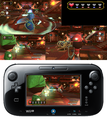The Legend of Zelda: Battle Quest: Difference between revisions
| Line 35: | Line 35: | ||
==Normal Mode== | ==Normal Mode== | ||
Normal mode can be played on any of nine stages, plus a few secret stages unlocked by completing these nine. It is available in multiplayer or solo modes. Solo players can choose between the GamePad and Wii Remote Plus. | Normal mode can be played on any of nine stages, plus a few secret stages unlocked by completing these nine. It is available in multiplayer or solo modes. Solo players can choose between the GamePad and Wii Remote Plus. | ||
Your goal in this mode is to defeat all of the enemies to obtain | Your goal in this mode is to defeat all of the enemies to obtain ''The Triforce''. | ||
The stages in this mode include: | The stages in this mode include: | ||
*The Grasslands | *The Grasslands. Enemies here consists of ''ChuChu'''s and ''Bokoblin''s. | ||
*A fortress | *A fortress | ||
*A forest | *A forest | ||
Revision as of 23:40, November 18, 2012
| This article describes a subject that is or may be outside the core Zelda canon. |
The Legend of Zelda: Battle Quest is one of 12 "attractions" that make up Nintendo Land, a release title for the Nintendo Wii U included in the Wii U Deluxe bundle, showcasing a variety of possibilities for asynchronous gameplay between the Wii U GamePad and Wii Remotes. Nintendo Land features minigames derived from 12 of Nintendo's top franchises, including The Legend of Zelda. Battle Quest is a minigame that allows one player using a bow controlled by the Wii U GamePad to adventure alongside up to three sword-wielding players using Wii Remotes.
This is not a full Zelda game, but a Zelda-themed minigame. Instead of Link, players control their Miis in outfits befitting Hyrulean adventurers. The game features multiple copies of the Master Sword, obviously not following the canon of the main series.
Gameplay
Battle Quest can be played with one to four players. The first player uses the GamePad to control an archer character who can pick off enemies at a distance or activate inaccessible switches, while the remaining players fight using swords controlled with Wii Remotes. All players move automatically along a linear, enemy-and-puzzle-infested path toward their destination.
In multiplayer mode, the game demonstrates the asynchronous gameplay made possible through the Wii U's unique GamePad. The player using the GamePad will have a different gameplay experience from the players using Wii Remotes. All players work together with pooled health to combat enemies and tackle obstacles. A colored rupee appears below each lost heart to indicate which player lost it.
Archer
Various motion sensors in the GamePad allow the archer player to look around the environment by moving the controller like a view finder. The screen also displays how much health and how many arrows the player has left. To fire an arrow, the player pulls down on the right analog stick and releases. Once the player runs out of arrows, he or she must lay the GamePad horizontal to refill the quiver. The player also has the option to adjust the view using the left analog stick.
Swordsmen
Like Skyward Sword, the players' swords use Wii MotionPlus to enable direct control of the swords' movements. Pressing 'B' halts the player's movement and raises his or her shield. Several skills are available, including the Spin Attack, and the Skyward Strike, returning from Skyward Sword.
Normal Mode
Normal mode can be played on any of nine stages, plus a few secret stages unlocked by completing these nine. It is available in multiplayer or solo modes. Solo players can choose between the GamePad and Wii Remote Plus. Your goal in this mode is to defeat all of the enemies to obtain The Triforce.
The stages in this mode include:
- The Grasslands. Enemies here consists of ChuChu's and Bokoblins.
- A fortress
- A forest
- A mountain
Time Attack
In Time Attack mode, one player races against the clock to defeat all of the enemies. It can be played on three different stages.
Development
Battle Quest was one of five minigames — along with Animal Crossing: Sweet Day, Luigi's Ghost Mansion, DK's Crash Course, and Takamaru's Ninja Castle — shown at the unveiling of Nintendo Land at E3 on June 5th, 2012.
Screenshots
Videos
Brief footage of the grassy level
Nintendo Land trailer, showing grass and mountain levels







